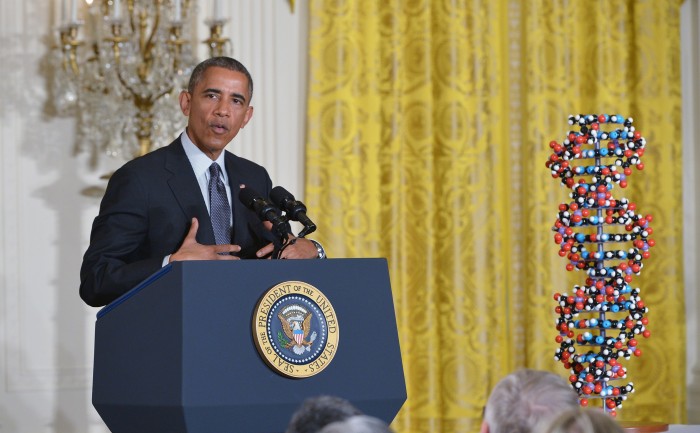The White House Is Pushing Precision Medicine, but It Won’t Happen for Years
With the right technologies to collect and make sense of biomedical information, we could speed up the pace of discoveries that lead to a new class of tailor-made drugs. That’s the argument behind the White House’s push for “precision medicine” (see “A Shot in the Arm for Obama’s Precision Medicine Initiative”).
The goal of precision medicine is to provide drugs and therapies that are uniquely suited to individual patients based on their genetics and other distinguishing health information. To a small degree, that already is happening. Dozens of targeted drugs have gotten approval from the U.S. Food and Drug Administration in recent years, and there are particularly successful examples in oncology. But despite the early successes, we are many years from realizing a “new era of medicine” the president described in his 2015 State of the Union address—if we can realize it at all.
Here are four reasons why:
1. The science is still young
The drug Herceptin became the first precision medicine in 1998 when it gained FDA approval for patients with a type of breast cancer caused by a specific genomic abnormality. A number of new drugs aimed at cancers characterized by particular abnormalities have since emerged. But not every patient with the target abnormalities responds to these drugs, and the reasons for that are not understood. Clues could be found by analyzing large collections of patient data that include genomic sequencing information as well as clinical data about which drugs the patients took and how they responded.
Valuable information will come from innovative clinical trials like the National Cancer Institute’s MATCH trial, in which thousands of patients are having their tumors sequenced to find genetic abnormalities for which there are targeted drugs. Data generated from such trials could help researchers determine what other genes may influence whether a drug works or not, says Richard Simon, associate director of the NCI’s division of cancer treatment and diagnosis.

Genetic abnormalities in the human genome can also contribute to the development of disease, including some cancers but also conditions like diabetes and heart disease. But while hundreds of these “variants” have been discovered, much is still unknown about what they mean medically.
2. The market for genetic testing is unproven
Getting to the next stage of precision medicine requires comprehensive, reliable genetic tests. Conventional diagnostic tests usually detect one or a small number of things at a time, like a key genomic abnormality. Now some companies are selling sophisticated tests based on advanced sequencing that can detect hundreds of abnormalities at once (see “The Great Cancer Test Experiment”).
But due in part to the lack of regulation by the FDA, the commercialization of diagnostic tests based on advanced sequencing has outpaced the underlying science of collecting and analyzing the data. Though high-quality tests are indeed available, many of the products on the market are questionable. Different tests can produce different results from the same DNA sample, says Elizabeth Mansfield, the deputy director of personalized medicine and molecular genetics for the FDA.
3. It’s expensive
These advanced sequencing tests can cost thousands of dollars, and the questions about their accuracy and clinical validity make insurance companies hesitant to pay for them. That’s why one company is giving away tumor sequencing tests to 100,000 cancer patients.
It’s also expensive to develop a targeted drug. In addition to developing the drug, the company must also spend resources or partner with another company to develop an accompanying diagnostic test, which must receive regulatory clearance at the same time. That policy may change, but in the meantime it may slow drug development.
Ultimately, some companies may decide that pursuing new “blockbuster” drugs for very common diseases is a better financial bet than chasing after a drug that might only work for a small number of people.
4. We need more data—and data sharing
Perhaps the biggest impediment to precision medicine is that so few people have gotten their genome, or their tumor’s genome, sequenced. That makes it difficult to find enough people to participate in clinical trials for new precision drugs, and limits the pace of scientific progress.
It’s not just genomic information that’s needed. The newly launched Precision Medicine Cohort project will establish a database of a million or more volunteers. In addition to sequencing data and medical records, it will contain information about the patients’ cells, proteins, and metabolites—and even data from mobile health tracking devices.
Generating this data isn’t enough, though. Combining it into large, shared databases could help illuminate patterns and connections that couldn’t be seen otherwise.
But competition leads academic researchers and businesses to keep this data private, and patients worry that sharing their data could compromise their privacy. These things must change if precision medicine is to advance, says Taha Kass-Hout, who recently stepped down after serving for three years as the FDA’s first chief health informatics officer. Companies and researchers should see that sharing data will help advance the entire field, he says. “It’s a win-win for everyone.”
Keep Reading
Most Popular
Large language models can do jaw-dropping things. But nobody knows exactly why.
And that's a problem. Figuring it out is one of the biggest scientific puzzles of our time and a crucial step towards controlling more powerful future models.
The problem with plug-in hybrids? Their drivers.
Plug-in hybrids are often sold as a transition to EVs, but new data from Europe shows we’re still underestimating the emissions they produce.
Google DeepMind’s new generative model makes Super Mario–like games from scratch
Genie learns how to control games by watching hours and hours of video. It could help train next-gen robots too.
How scientists traced a mysterious covid case back to six toilets
When wastewater surveillance turns into a hunt for a single infected individual, the ethics get tricky.
Stay connected
Get the latest updates from
MIT Technology Review
Discover special offers, top stories, upcoming events, and more.